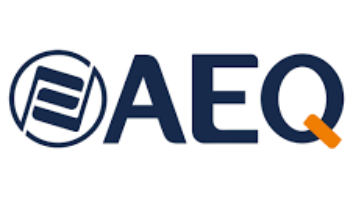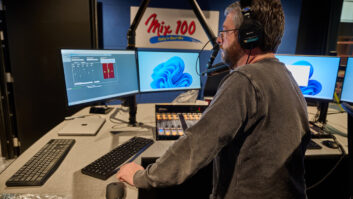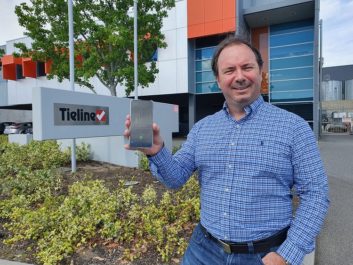 Charlie Gawley is VP Sales APAC/EMEA of Tieline.
Charlie Gawley is VP Sales APAC/EMEA of Tieline.
This article appeared in Radio World’s “Trends in Codecs and STLs for 2020” ebook.
RW: What’s the biggest trend in this segment of our industry?
Charlie Gawley: Remote control and simple connections are paramount these days. The pandemic has accelerated this demand, but thankfully Tieline was already well-placed to put remote control of all equipment at the engineer’s fingertips.
From a network control perspective, cloud management of all devices is expected. As an example, Tieline’s Cloud Codec Controller lets engineers fully configure and remote control all their codecs remotely from the studio or home. Our Report-IT app can be connected, monitored and allow remote input level adjustment as well. This has been extremely important during the pandemic, as a broadcast engineer can adjust remote audio levels and other settings as required from their own home.
Simple connections are also facilitated by a traversal server like Tieline’s TieLink, which allows creation of call groups, displays codec “presence” and facilitates NAT traversal.
RW: How do you see codec technologies being deployed now in clients’ facilities?
Gawley: Today there are demands to do more with less — essentially looking for that Swiss Army tool in your broadcast kit.
The ViA portable IP mixer/codec has enabled broadcasters to essentially set up a remote operational studio where they can take live calls over SIP, Skype, WhatsApp and mix directly live on-air. Users have been able to do their prerecorded interviews or commercials and either mix them in live on-air or FTP files back to the studio.
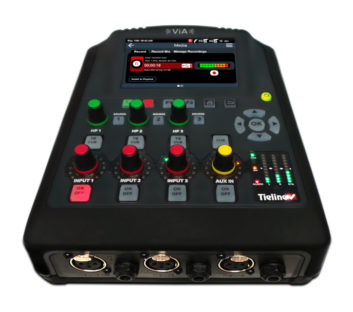
As an example, we have a large national broadcaster in the United Kingdom that has set up a live mixing studio for both radio and TV programs from an engineers’ lounge room due to COVID-19 lockdown restrictions using two ViAs each in triple mono mode. They are connected to four presenters on ViAs in their own homes — all mixed in the lounge room with program audio sent to a Merlin PLUS multichannel codec in Master Control. A producer is connected over Tieline’s Report-IT app to the Merlin PLUS, where a comms channel is fed to the talent off-air.
RW: How about 2020’s “big story,” the sudden explosion in remote and at-home broadcasting?
Gawley: Codecs have played a crucial role in facilitating home broadcasting and keeping stations on-air after the pandemic forced networks to send people home.
For the seasoned Tieline user broadcasting remotely for over two decades, broadcasting from home is just another venue. However, for studio-based talent it would be foreign to them.
There have been two dominant use cases. One involves broadcasters at home using full-featured codecs like the Tieline ViA with record and playback capability and the ability to integrate live callers in a home studio. These codecs also delivered redundant streaming over multiple IP interfaces like cellular and wired interfaces and data aggregation technologies.
The second use case involved rapid deployment to multiple people in an affordable and simple way. Our Report-IT Enterprise app for iOS and Android allowed users to download a software codec and tap “connect” to go live very simply. All the configuration was done remotely by the engineer at the studio or from their home.
[Check Out More of Radio World’s Ebooks Here]
RW: How many ways are there of making connections?
Gawley: Sales of ISDN and POTS-capable codecs have definitely tapered off, and everyone has either moved or is moving towards IP audio transport.
From an IP perspective, many codecs support unicast peer-to-peer connections or can multi-unicast to dozens of endpoints. Multicasting is also supported to unlimited endpoints over multicast-capable networks. Codec IP audio streams can be delivered over any IP network and integrate seamlessly with all AES67-compatible broadcast studios.
RW: And how powerful do you think codecs can get?
Gawley: Just as processors get more powerful, so do codecs. Today’s leading codecs increasingly include more features and options than ever before. For example, audio processing like EQ, compression and limiting is performed in some. Multiple connections can be configured with multiple redundant streams and data aggregation.
RW: What best practice tips should buyers be aware of in 2020?
Gawley: From an STL and audio distribution perspective, the codecs of today increasingly integrate high-density streaming features, which deliver scalable, space-saving options. It’s what our customers are demanding.
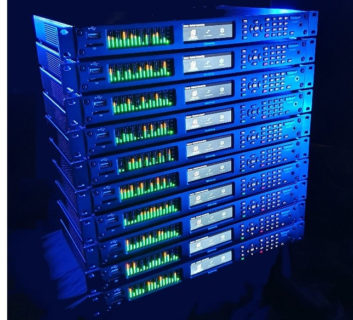
For example, our new Gateway multichannel DSP-powered codec delivers 16 codecs in a compact 1RU design with flexible analog, AES3 and AES67 I/O. From a remote broadcast perspective, the leading codecs can connect multiple streams for program and separate communications or can stream to multiple endpoints simultaneously. When bandwidth becomes limited the leading codecs offer network data aggregation in addition to stream diversity.
Record and playback, FTP upload/download, audio processing (EQ, limiting and compression), redundant streaming and data aggregation, are just some of the features buyers should look out for.
RW: How have AoIP technology developments been reflected in the look and function of codecs?
Gawley: Audio over IP has been Tieline’s bread and butter for over 16 years, enabling broadcasters to send audio over the public internet, and is nothing new to us.
Tieline had implemented strategies to mitigate packet loss with forward error correction and auto jitter buffer techniques while other codec manufacturers were stipulating use of the five 9 MPLS networks. In 2007 the EBU foreshadowed that ISDN one day would cease to exist and wanted to have a similar level of interoperability over IP. They set up a working party, which Tieline was a member of, that gave rise to the EBU 3326 Interoperability standard over IP with the SIP protocol at its core, and Tieline was the first non-European manufacturer to implement the standard alongside AEQ, AETA, Orban and Mayah.
Fast-forward a number of years, the studio has caught up to where AoIP in the studio is rapidly becoming the norm. Tieline was ahead of the curve implementing the WheatNet-IP protocol in its codecs, from there others added Livewire, Ravenna and Dante. Given all these different proprietary AoIP standards, both the AES and EBU got the industry together and now we have AES67.
RW: And what will codecs look like in the future, if we use them at all?
Gawley: Codecs will be required for as long as IP networks are imperfect, which is the foreseeable future.
It’s true that some networks can carry full bandwidth PCM audio over fiber, but these networks generally make up the backbone of larger networks and their primary studio-to-studio infrastructure. Transmitter sites often don’t have fiber runs due to their location or the expense of installation. Remotes are performed from anywhere and often rely on cellular and other wired services that still require a codec to reliably transport audio.
Lossy networks like the internet are imperfect and still require “smart” IP technology to reliably transport audio due to jitter and packet loss; this is where one should look for bit-stream diversity.
Despite significant advances and increases in available bandwidth, cellular networks can at times suffer from capacity constraints. This is where data bonding/aggregation comes into play and one should look for this to be included in a codec, rather than as a clunky peripheral piece of hardware that introduces an additional point of failure.









